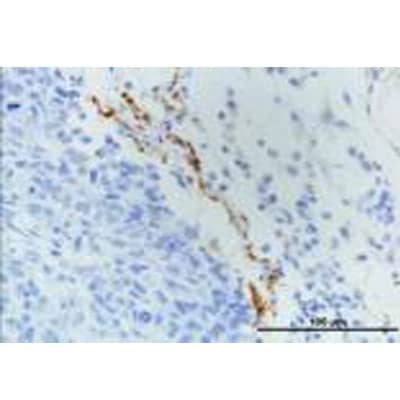| Reactivity | Hu, Mu, RtSpecies Glossary |
| Applications | WB, Flow, IHC |
| Clonality | Polyclonal |
| Host | Rabbit |
| Conjugate | Unconjugated |
| Format | BSA Free |
| Concentration | 1.0 mg/ml |
| Immunogen | This LYVE-1 Antibody was developed against a synthetic peptide made to a C-terminal portion of the mouse LYVE1 protein sequence (between residues 250-318). [UniProt# Q8BHC0] |
| Localization | Plasma membrane |
| Marker | Lymphatic Vessel Marker |
| Isotype | IgG |
| Clonality | Polyclonal |
| Host | Rabbit |
| Gene | LYVE1 |
| Purity | Immunogen affinity purified |
| Innovator's Reward | Test in a species/application not listed above to receive a full credit towards a future purchase. |
| Dilutions |
|
||
| Application Notes | In Western Blot, a band at ~52 kDa is seen. For Immunohistochemistry citrate buffer antigen retrieval is recommended. |
||
| Theoretical MW | 35 kDa. Disclaimer note: The observed molecular weight of the protein may vary from the listed predicted molecular weight due to post translational modifications, post translation cleavages, relative charges, and other experimental factors. |
||
| Control |
|
||
| Control Peptide |
|
||
| Reviewed Applications |
|
||
| Publications |
|
| Storage | Store at 4C short term. Aliquot and store at -20C long term. Avoid freeze-thaw cycles. |
| Buffer | PBS |
| Preservative | 0.02% Sodium Azide |
| Concentration | 1.0 mg/ml |
| Purity | Immunogen affinity purified |
| Images | Ratings | Applications | Species | Date | Details | ||||||||
|---|---|---|---|---|---|---|---|---|---|---|---|---|---|
-(01-ml)_NB100-725_8631.png)
Enlarge |
reviewed by:
Bryan Tinsley |
WB | Human | 07/01/2014 |
Summary
|
||||||||

Enlarge |
reviewed by:
Corey . |
IHC-P | Human | 03/19/2013 |
Summary
|
Secondary Antibodies |
Isotype Controls |
Research Areas for LYVE-1 Antibody (NB100-725)Find related products by research area.
|
|
Meningeal lymphatics: recent discovery defying the concept of central nervous system 'immune privilege' By Jennifer Sokolowski, MD, PhD. Identification and characterization of meningeal lymphaticsThe recent discovery of a lymphatic system in the meninges surrounding the brain and spinal cord has spurred a surge of int... Read full blog post. |
The concentration calculator allows you to quickly calculate the volume, mass or concentration of your vial. Simply enter your mass, volume, or concentration values for your reagent and the calculator will determine the rest.
5 | |
4 | |
3 | |
2 | |
1 |
| Bryan Tinsley 07/01/2014 |
||
| Application: | WB | |
| Species: | Human |
| Corey . 03/19/2013 |
||
| Application: | IHC-P | |
| Species: | Human |
| Gene Symbol | LYVE1 |